Complete Health Indicator Report of Climate Change: Greenhouse Gases
Definition
Greenhouse gases include water vapor, carbon dioxide (CO2), methane, and nitrous oxide, all of which play an important role in regulating the Earth's temperature. These gases help create the greenhouse effect, a process in which greenhouse gases absorb infrared radiation from the sun and contain the heat in the atmosphere.Numerator
Carbon dioxide emissions (as measured in millions of metric tons).Denominator
Not ApplicableWhy Is This Important?
The design and layout of Utah cities and neighborhoods have a substantial effect on the health of all Utahns. Urban sprawl, inadequate public transportation, and energy-inefficient buildings not only affect human health but also have a distinct impact on climate change through the generation of greenhouse gas emissions. More greenhouse gases in the atmosphere, particularly carbon dioxide, will disrupt the balance between energy absorbed and energy emitted, causing greater amounts of heat to be trapped at the Earth's surface and ultimately increasing surface temperatures. Excess carbon dioxide emissions is strongly linked to human activities, primarily through the burning of fossil fuels. In fact, most greenhouse gas emissions in the United States come from energy use. Within the United States, carbon dioxide emissions from petroleum and natural gas represent 82% of the total man-made greenhouse gas emissions [1].Graphical Data Views
Greenhouse Gases: Total Carbon Dioxide Emissions from All Energy Sectors by Year, Utah, 1980-2019
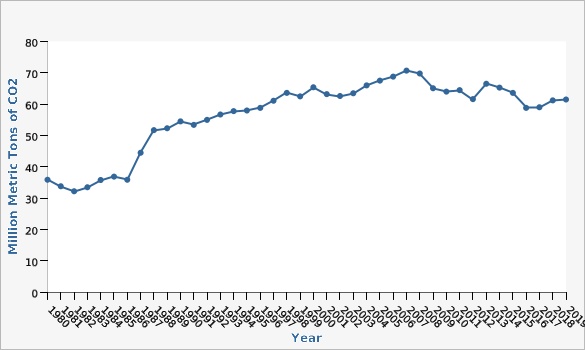
| Year | Million Metric Tons of CO2 | |||||
|---|---|---|---|---|---|---|
Record Count: 40 | ||||||
| 1980 | 35.9 | |||||
| 1981 | 33.8 | |||||
| 1982 | 32.2 | |||||
| 1983 | 33.5 | |||||
| 1984 | 35.8 | |||||
| 1985 | 36.9 | |||||
| 1986 | 35.9 | |||||
| 1987 | 44.5 | |||||
| 1988 | 51.7 | |||||
| 1989 | 52.3 | |||||
| 1990 | 54.5 | |||||
| 1991 | 53.4 | |||||
| 1992 | 55.0 | |||||
| 1993 | 56.7 | |||||
| 1994 | 57.8 | |||||
| 1995 | 58.0 | |||||
| 1996 | 58.8 | |||||
| 1997 | 61.1 | |||||
| 1998 | 63.6 | |||||
| 1999 | 62.5 | |||||
| 2000 | 65.4 | |||||
| 2001 | 63.2 | |||||
| 2002 | 62.6 | |||||
| 2003 | 63.5 | |||||
| 2004 | 66.0 | |||||
| 2005 | 67.5 | |||||
| 2006 | 68.8 | |||||
| 2007 | 70.7 | |||||
| 2008 | 69.8 | |||||
| 2009 | 65.1 | |||||
| 2010 | 64.0 | |||||
| 2011 | 64.5 | |||||
| 2012 | 61.6 | |||||
| 2013 | 66.5 | |||||
| 2014 | 65.3 | |||||
| 2015 | 63.6 | |||||
| 2016 | 58.8 | |||||
| 2017 | 59.0 | |||||
| 2018 | 61.2 | |||||
| 2019 | 61.5 | |||||
Data Source
U.S. Energy Information Administration, State Carbon Dioxide EmissionsGreenhouse Gases: Carbon Dioxide Emissions by Sector (Residential and Commercial) and Year, Utah, 1980-2019
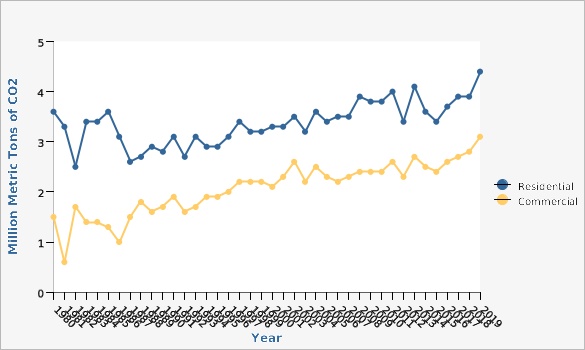
Commercial and residential buildings use an abundance of energy and emit a large amount of carbon dioxide. In the United States, commercial and residential buildings (known as the building sector) use more energy than the transportation and industrial sectors and emit more carbon dioxide than both sectors. As of 1998, the building sector in the United States consumed 36% of the nation's energy and consequently, contributed to 35% of the carbon dioxide emissions [1]. Within the building sector, electricity is a large source of energy consumption, which is fueled primarily by coal. By 2006, 83% of carbon dioxide emissions in the United States were generated by the electric power sector [2].
The material used to construct the building, design, and location of buildings all have implications in terms of greenhouse gas emissions. Sustainable building materials and architectural designs that promote energy efficiency help reduce greenhouse gas emissions in the building sector. Additionally, electricity used for water, heating, cooling, and lighting produce substantial amounts of carbon dioxide emissions. Engaging in efficient practices when using electricity for these purposes as well as utilizing energy efficient appliances can also help reduce carbon dioxide emissions among the building sector.[[br]]
| Residential vs. Commercial | Year | Million Metric Tons of CO2 | ||||
|---|---|---|---|---|---|---|
Record Count: 80 | ||||||
| Residential | 1980 | 3.6 | ||||
| Residential | 1981 | 3.3 | ||||
| Residential | 1982 | 2.5 | ||||
| Residential | 1983 | 3.4 | ||||
| Residential | 1984 | 3.4 | ||||
| Residential | 1985 | 3.6 | ||||
| Residential | 1986 | 3.1 | ||||
| Residential | 1987 | 2.6 | ||||
| Residential | 1988 | 2.7 | ||||
| Residential | 1989 | 2.9 | ||||
| Residential | 1990 | 2.8 | ||||
| Residential | 1991 | 3.1 | ||||
| Residential | 1992 | 2.7 | ||||
| Residential | 1993 | 3.1 | ||||
| Residential | 1994 | 2.9 | ||||
| Residential | 1995 | 2.9 | ||||
| Residential | 1996 | 3.1 | ||||
| Residential | 1997 | 3.4 | ||||
| Residential | 1998 | 3.2 | ||||
| Residential | 1999 | 3.2 | ||||
| Residential | 2000 | 3.3 | ||||
| Residential | 2001 | 3.3 | ||||
| Residential | 2002 | 3.5 | ||||
| Residential | 2003 | 3.2 | ||||
| Residential | 2004 | 3.6 | ||||
| Residential | 2005 | 3.4 | ||||
| Residential | 2006 | 3.5 | ||||
| Residential | 2007 | 3.5 | ||||
| Residential | 2008 | 3.9 | ||||
| Residential | 2009 | 3.8 | ||||
| Residential | 2010 | 3.8 | ||||
| Residential | 2011 | 4.0 | ||||
| Residential | 2012 | 3.4 | ||||
| Residential | 2013 | 4.1 | ||||
| Residential | 2014 | 3.6 | ||||
| Residential | 2015 | 3.4 | ||||
| Residential | 2016 | 3.7 | ||||
| Residential | 2017 | 3.9 | ||||
| Residential | 2018 | 3.9 | ||||
| Residential | 2019 | 4.4 | ||||
| Commercial | 1980 | 1.5 | ||||
| Commercial | 1981 | 0.6 | ||||
| Commercial | 1982 | 1.7 | ||||
| Commercial | 1983 | 1.4 | ||||
| Commercial | 1984 | 1.4 | ||||
| Commercial | 1985 | 1.3 | ||||
| Commercial | 1986 | 1.0 | ||||
| Commercial | 1987 | 1.5 | ||||
| Commercial | 1988 | 1.8 | ||||
| Commercial | 1989 | 1.6 | ||||
| Commercial | 1990 | 1.7 | ||||
| Commercial | 1991 | 1.9 | ||||
| Commercial | 1992 | 1.6 | ||||
| Commercial | 1993 | 1.7 | ||||
| Commercial | 1994 | 1.9 | ||||
| Commercial | 1995 | 1.9 | ||||
| Commercial | 1996 | 2.0 | ||||
| Commercial | 1997 | 2.2 | ||||
| Commercial | 1998 | 2.2 | ||||
| Commercial | 1999 | 2.2 | ||||
| Commercial | 2000 | 2.1 | ||||
| Commercial | 2001 | 2.3 | ||||
| Commercial | 2002 | 2.6 | ||||
| Commercial | 2003 | 2.2 | ||||
| Commercial | 2004 | 2.5 | ||||
| Commercial | 2005 | 2.3 | ||||
| Commercial | 2006 | 2.2 | ||||
| Commercial | 2007 | 2.3 | ||||
| Commercial | 2008 | 2.4 | ||||
| Commercial | 2009 | 2.4 | ||||
| Commercial | 2010 | 2.4 | ||||
| Commercial | 2011 | 2.6 | ||||
| Commercial | 2012 | 2.3 | ||||
| Commercial | 2013 | 2.7 | ||||
| Commercial | 2014 | 2.5 | ||||
| Commercial | 2015 | 2.4 | ||||
| Commercial | 2016 | 2.6 | ||||
| Commercial | 2017 | 2.7 | ||||
| Commercial | 2018 | 2.8 | ||||
| Commercial | 2019 | 3.1 | ||||
Data Source
U.S. Energy Information Administration, State Carbon Dioxide EmissionsGreenhouse Gases: Carbon Dioxide Emissions due to Transportation by Year, Utah, 1980-2019
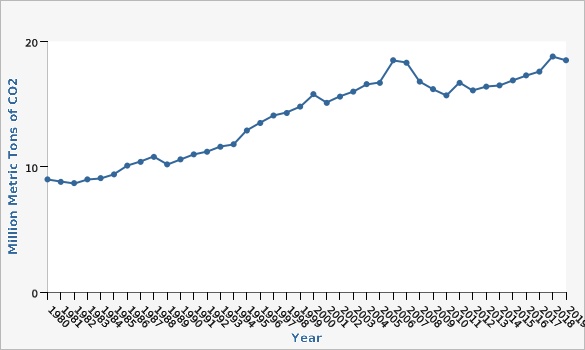
The location and interaction between highways, public transit, and roads affect driving behaviors, which affects the amount of carbon dioxide emitted into the atmosphere. As of 2006, 28% of total greenhouse gas emissions in the United States came from transportation, while 94% of those emissions were from carbon dioxide [1]. Commuting long distances to work, school, the grocery store, and other destinations require Utahns to rely on vehicles, which contributes to the generation of carbon dioxide emissions. Mixed-use neighborhoods (communities that integrate businesses and residential buildings), biking or walking, and utilizing public transportation are excellent strategies to reduce vehicle emissions. Yet, if community layouts do not promote alternative forms of transportation, technological advances for vehicles may help in reducing emissions. Strategies include the creation of low carbon fuels and improved vehicle design and technology [4]. A reduction in carbon dioxide emissions due to technological advances or decreased vehicle usage has an effect on human health. Alternative modes of transportation, such as walking or biking, provide needed physical activity and can reduce the risk for a variety of diseases. Furthermore, reduced carbon dioxide emissions can help prevent air pollutants from becoming trapped at the Earth's surface and causing respiratory infections and exacerbating asthma. Any reduction in vehicle-induced carbon dioxide emissions can help mitigate climate change and improve human health.[[br]]
| Year | Million Metric Tons of CO2 | |||||
|---|---|---|---|---|---|---|
Record Count: 40 | ||||||
| 1980 | 9.0 | |||||
| 1981 | 8.8 | |||||
| 1982 | 8.7 | |||||
| 1983 | 9.0 | |||||
| 1984 | 9.1 | |||||
| 1985 | 9.4 | |||||
| 1986 | 10.1 | |||||
| 1987 | 10.4 | |||||
| 1988 | 10.8 | |||||
| 1989 | 10.2 | |||||
| 1990 | 10.6 | |||||
| 1991 | 11.0 | |||||
| 1992 | 11.2 | |||||
| 1993 | 11.6 | |||||
| 1994 | 11.8 | |||||
| 1995 | 12.9 | |||||
| 1996 | 13.5 | |||||
| 1997 | 14.1 | |||||
| 1998 | 14.3 | |||||
| 1999 | 14.8 | |||||
| 2000 | 15.8 | |||||
| 2001 | 15.1 | |||||
| 2002 | 15.6 | |||||
| 2003 | 16.0 | |||||
| 2004 | 16.6 | |||||
| 2005 | 16.7 | |||||
| 2006 | 18.5 | |||||
| 2007 | 18.3 | |||||
| 2008 | 16.8 | |||||
| 2009 | 16.2 | |||||
| 2010 | 15.7 | |||||
| 2011 | 16.7 | |||||
| 2012 | 16.1 | |||||
| 2013 | 16.4 | |||||
| 2014 | 16.5 | |||||
| 2015 | 16.9 | |||||
| 2016 | 17.3 | |||||
| 2017 | 17.6 | |||||
| 2018 | 18.8 | |||||
| 2019 | 18.5 | |||||
Data Source
U.S. Energy Information Administration, State Carbon Dioxide EmissionsGreenhouse Gases: Carbon Dioxide Emissions due to Electric Power by Year, Utah, 1980-2019
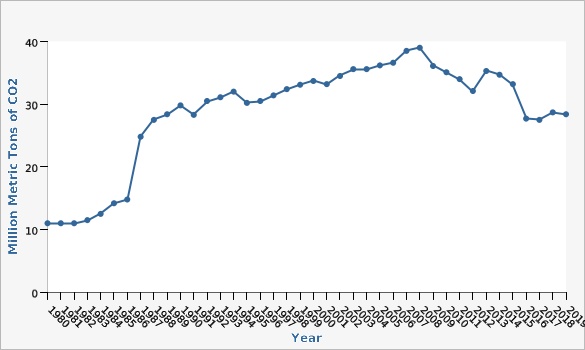
Fossil fuels are a common means to produce electricity. When these types of fuels are burned, they release greenhouse gases into the atmosphere. In Utah, approximately 98% of electricity production comes from fossil fuel-based power plants (coal, natural gas, and crude oil) [1].
Strategies to reduce greenhouse gas emissions from electric power include transitioning to renewable energy sources, making power plants more efficient, reducing demand for electricity in homes and industry, and Carbon Capture Sequestration and Storage [2].[[br]]
| Year | Million Metric Tons of CO2 | |||||
|---|---|---|---|---|---|---|
Record Count: 40 | ||||||
| 1980 | 11.0 | |||||
| 1981 | 11.0 | |||||
| 1982 | 11.0 | |||||
| 1983 | 11.5 | |||||
| 1984 | 12.5 | |||||
| 1985 | 14.2 | |||||
| 1986 | 14.8 | |||||
| 1987 | 24.8 | |||||
| 1988 | 27.5 | |||||
| 1989 | 28.4 | |||||
| 1990 | 29.8 | |||||
| 1991 | 28.3 | |||||
| 1992 | 30.5 | |||||
| 1993 | 31.1 | |||||
| 1994 | 32.0 | |||||
| 1995 | 30.2 | |||||
| 1996 | 30.5 | |||||
| 1997 | 31.4 | |||||
| 1998 | 32.4 | |||||
| 1999 | 33.1 | |||||
| 2000 | 33.7 | |||||
| 2001 | 33.2 | |||||
| 2002 | 34.5 | |||||
| 2003 | 35.6 | |||||
| 2004 | 35.6 | |||||
| 2005 | 36.2 | |||||
| 2006 | 36.6 | |||||
| 2007 | 38.5 | |||||
| 2008 | 39.0 | |||||
| 2009 | 36.1 | |||||
| 2010 | 35.1 | |||||
| 2011 | 34.0 | |||||
| 2012 | 32.1 | |||||
| 2013 | 35.3 | |||||
| 2014 | 34.7 | |||||
| 2015 | 33.2 | |||||
| 2016 | 27.7 | |||||
| 2017 | 27.5 | |||||
| 2018 | 28.7 | |||||
| 2019 | 28.4 | |||||
Data Source
U.S. Energy Information Administration, State Carbon Dioxide EmissionsGreenhouse Gases: Carbon Dioxide Emissions from the Industrial Sector by Year, Utah, 1980-2019
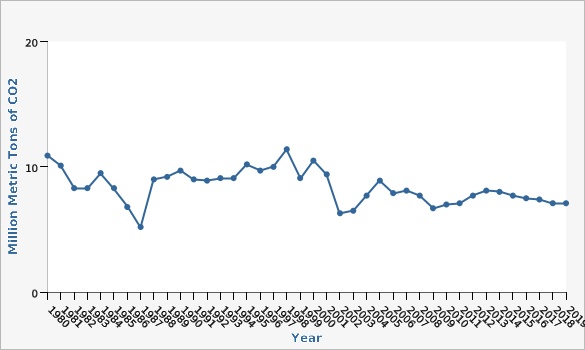
When industries make products, they can release greenhouse gases as part of the production process. Greenhouse gas emissions from the Industrial Sector has been divided into two categories: direct and indirect emissions [1].
The EPA defines direct emissions as greenhouse gases that are "produced by burning fuel for power or heat, through chemical reactions, and from leaks from industrial processes or equipment. Most direct emissions come from the consumption of fossil fuels for energy. A smaller amount, roughly a third, come from leaks from natural gas and petroleum systems, the use of fuels in production (e.g., petroleum products used to make plastics), and chemical reactions during the production of chemicals, iron and steel, and cement." [1]
The EPA defines indirect emissions as greenhouse gases that are "produced by burning fossil fuel at a power plant to make electricity, which is then used by an industrial facility to power industrial buildings and machinery." [1][[br]]
[[br]]
| Year | Million Metric Tons of CO2 | |||||
|---|---|---|---|---|---|---|
Record Count: 40 | ||||||
| 1980 | 10.9 | |||||
| 1981 | 10.1 | |||||
| 1982 | 8.3 | |||||
| 1983 | 8.3 | |||||
| 1984 | 9.5 | |||||
| 1985 | 8.3 | |||||
| 1986 | 6.8 | |||||
| 1987 | 5.2 | |||||
| 1988 | 9.0 | |||||
| 1989 | 9.2 | |||||
| 1990 | 9.7 | |||||
| 1991 | 9.0 | |||||
| 1992 | 8.9 | |||||
| 1993 | 9.1 | |||||
| 1994 | 9.1 | |||||
| 1995 | 10.2 | |||||
| 1996 | 9.7 | |||||
| 1997 | 10.0 | |||||
| 1998 | 11.4 | |||||
| 1999 | 9.1 | |||||
| 2000 | 10.5 | |||||
| 2001 | 9.4 | |||||
| 2002 | 6.3 | |||||
| 2003 | 6.5 | |||||
| 2004 | 7.7 | |||||
| 2005 | 8.9 | |||||
| 2006 | 7.9 | |||||
| 2007 | 8.1 | |||||
| 2008 | 7.7 | |||||
| 2009 | 6.7 | |||||
| 2010 | 7.0 | |||||
| 2011 | 7.1 | |||||
| 2012 | 7.7 | |||||
| 2013 | 8.1 | |||||
| 2014 | 8.0 | |||||
| 2015 | 7.7 | |||||
| 2016 | 7.5 | |||||
| 2017 | 7.4 | |||||
| 2018 | 7.1 | |||||
| 2019 | 7.1 | |||||
Data Source
U.S. Energy Information Administration, State Carbon Dioxide EmissionsReferences and Community Resources
1. U.S. Energy Information Administration. (2011). Emissions of Greenhouse Gases in the United States 2009. Retrieved on April 9, 2015 from [http://www.eia.gov/environment/emissions/ghg_report/pdf/0573%282009%29.pdf] 2. Battles, S., & Burns, E. (2000). Trends in Building-Related Energy and Carbon Emissions: Actual and Alternate Scenarios. Summer Study on Energy Efficiency in Buildings, August, 21. 3. Younger, M., Morrow-Almeida, H. R., Vindigni, S. M., & Dannenberg, A. L. (2008). The built environment, climate change, and health: opportunities for co-benefits. American Journal of Preventive Medicine, 35(5), 517-526. 4. U.S. Environmental Protection Agency. (2018). Reducing Greenhouse Gas Emissions. Retrieved on April 11, 2018 from [https://www.epa.gov/ghgemissions/sources-greenhouse-gas-emissions#transportation] 5. U.S. Energy Information Administration. (n.d.). Utah: State Profile and Energy Estimates. Retrieved on January 12, 2017 from [http://www.eia.gov/state/?sid=UT] 6. U.S. Environmental Production Agency. (2016). Electricity Sector Emissions. Retrieved on January 12, 2017 from [https://www.epa.gov/ghgemissions/sources-greenhouse-gas-emissions] 7. U.S. Environmental Protection Agency. (2016). Industry Sector Emissions. Retrieved on January 12, 2017 from [https://www.epa.gov/ghgemissions/sources-greenhouse-gas-emissions]More Resources and Links
Evidence-based community health improvement ideas and interventions may be found at the following sites:- Centers for Disease Control and Prevention (CDC) WONDER Database, a system for disseminating public health data and information.
- United States Census Bureau data dashboard.
- Utah healthy Places Index, evidence-based and peer-reviewed tool, supports efforts to prioritize equitable community investments, develop critical programs and policies across the state, and much more.
- County Health Rankings
- Kaiser Family Foundation's StateHealthFacts.org
- Medical literature can be queried at PubMed library.
Page Content Updated On 05/20/2022,
Published on 07/07/2022
